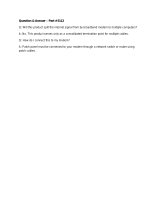
FTP operation························································································································································· 85
Configuring the FTP client ············································································································································· 86
Establishing an FTP connection···························································································································· 86
Operating the directories on an FTP server········································································································ 87
Operating the files on an FTP server ··················································································································· 88
Using another username to log in to an FTP server ··························································································· 89
Maintaining and debugging an FTP connection································································································ 89
Terminating an FTP connection ···························································································································· 89
FTP client configuration example························································································································· 90
Configuring the FTP server ············································································································································ 91
Configuring FTP server operating parameters···································································································· 91
Configuring authentication and authorization on the FTP server ····································································· 92
FTP server configuration example························································································································ 93
Displaying and maintaining FTP··································································································································· 95
TFTP configuration······················································································································································96
TFTP overview································································································································································· 96
Introduction to TFTP ··············································································································································· 96
TFTP operation ······················································································································································· 96
Configuring the TFTP client············································································································································ 97
Displaying and maintaining the TFTP client ················································································································ 98
TFTP client configuration example································································································································98
File management····················································································································································· 100
Managing files ·····························································································································································100
Filename formats ·················································································································································100
Performing directory operations ·································································································································100
Displaying directory information ·······················································································································101
Displaying the current working directory··········································································································101
Changing the current working directory···········································································································101
Creating a directory············································································································································101
Removing a directory··········································································································································101
Performing file operations ···········································································································································101
Displaying file information ·································································································································102
Displaying the contents of a file·························································································································102
Renaming a file····················································································································································102
Copying a file······················································································································································102
Moving a file························································································································································102
Deleting a file·······················································································································································102
Restoring a file from the recycle bin··················································································································103
Emptying the recycle bin ····································································································································103
Performing batch operations·······································································································································103
Performing storage medium operations·····················································································································104
Managing the space of a storage medium ······································································································104
Setting prompt modes··················································································································································104
Example for file operations ·········································································································································104
Configuration file management ····························································································································· 106
Configuration file overview·········································································································································106
Types of configuration ········································································································································106
Format and content of a configuration file ·······································································································106
Coexistence of multiple configuration files ·······································································································107
Startup with the configuration file······················································································································107
Saving the running configuration ·······························································································································107
Introduction ··························································································································································107
Modes in saving the configuration····················································································································107
iii




















